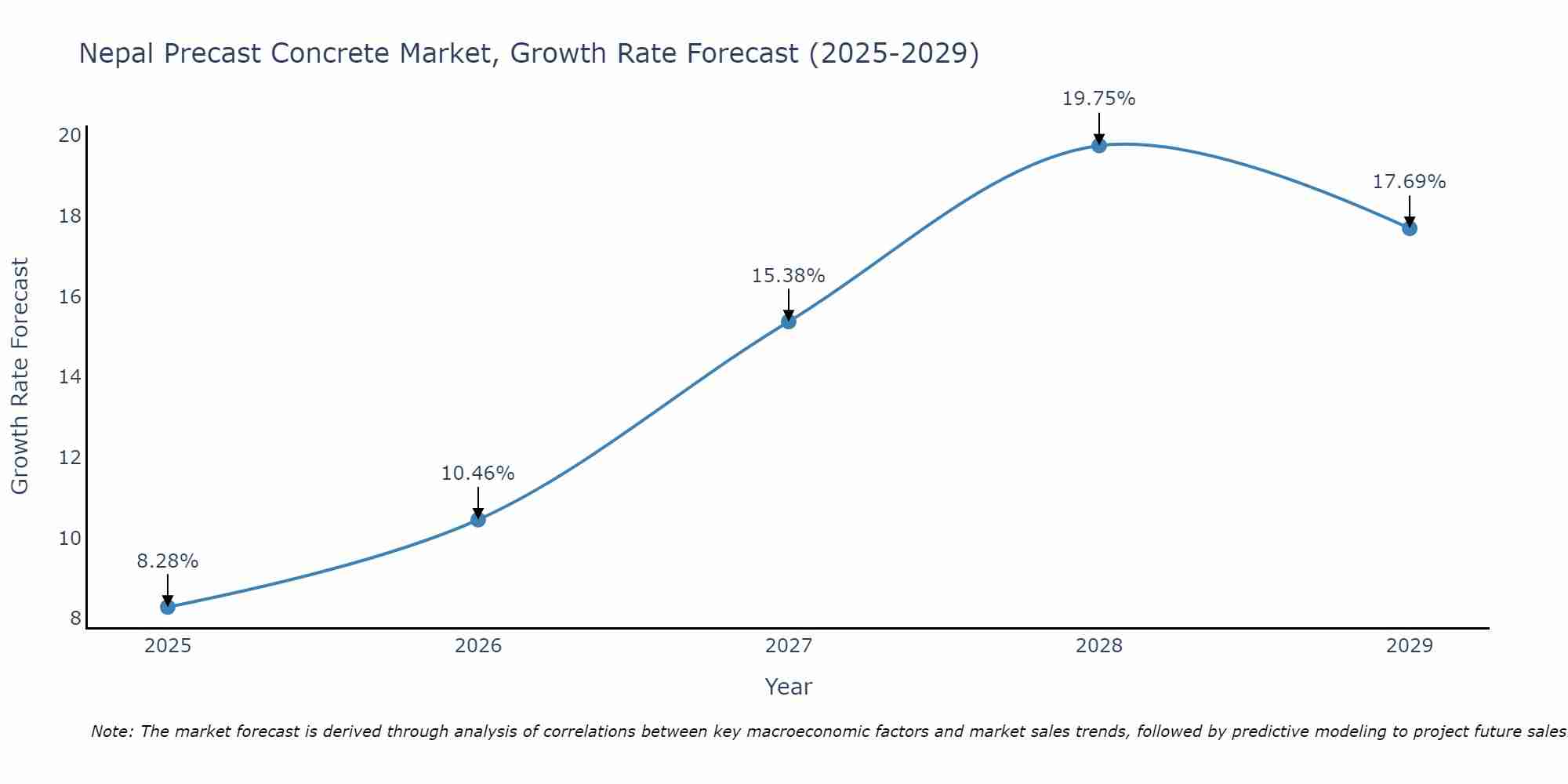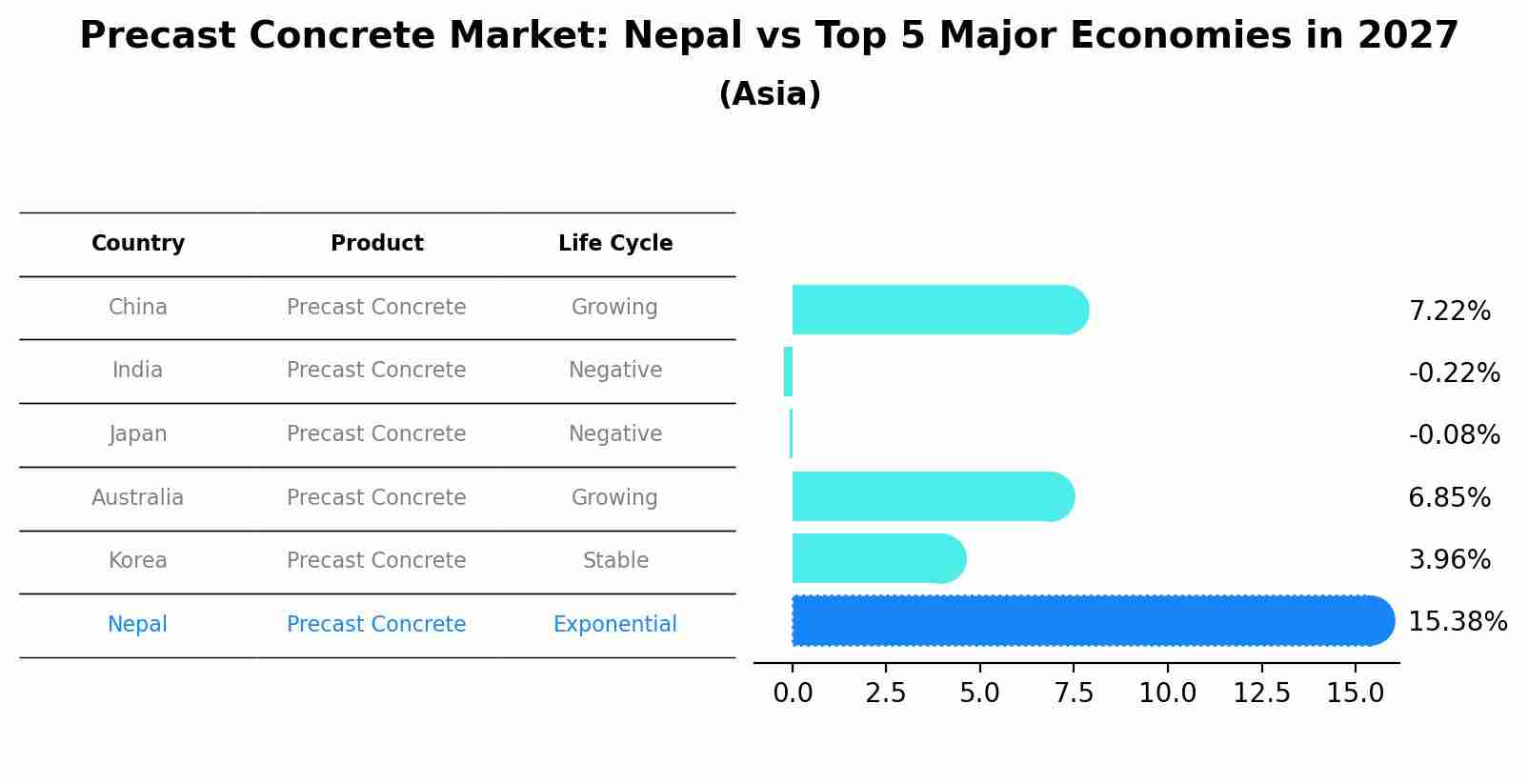Nepal Precast Concrete Market (2025-2031) Outlook | Growth, Forecast, Industry, Size, Revenue, Trends, Share, Companies, Analysis & Value
| Product Code: ETC372876 | Publication Date: Aug 2022 | Updated Date: Jul 2025 | Product Type: Market Research Report | |
| Publisher: 6Wresearch | Author: Shubham Padhi | No. of Pages: 75 | No. of Figures: 35 | No. of Tables: 20 |
Nepal Precast Concrete Market Size Growth Rate
The Nepal Precast Concrete Market is projected to witness mixed growth rate patterns during 2025 to 2029. The growth rate begins at 8.28% in 2025, climbs to a high of 19.75% in 2028, and moderates to 17.69% by 2029.

Precast Concrete Market: Nepal vs Top 5 Major Economies in 2027 (Asia)
In the Asia region, the Precast Concrete market in Nepal is projected to expand at a exponential growth rate of 15.38% by 2027. The largest economy is China, followed by India, Japan, Australia and South Korea.

Nepal Precast Concrete Market Synopsis
The Nepal precast concrete market is experiencing significant growth due to the country`s increasing infrastructure development projects, urbanization, and government initiatives promoting the use of precast concrete technology. Precast concrete products such as walls, slabs, beams, and columns are in high demand for residential, commercial, and industrial construction projects due to their durability, cost-effectiveness, and faster construction time. Key market players are investing in expanding their production capacity and introducing advanced technologies to meet the growing demand in the market. Factors such as earthquake resistance, sustainable construction practices, and the ability to customize designs are driving the adoption of precast concrete solutions in Nepal, making it a promising sector with opportunities for further expansion and innovation.
Nepal Precast Concrete Market Trends
The Nepal precast concrete market is currently experiencing growth due to the increasing demand for cost-effective and sustainable construction solutions. Key trends in the market include a rising preference for precast concrete products in infrastructure projects such as bridges, flyovers, and residential buildings. Additionally, the adoption of advanced technologies in precast concrete production, such as 3D printing and automation, is improving efficiency and quality in the manufacturing process. The market is also witnessing a shift towards eco-friendly practices, with a focus on using recycled materials and reducing carbon emissions in precast concrete production. Overall, the Nepal precast concrete market is expected to continue expanding as the construction industry increasingly recognizes the benefits of precast solutions in terms of speed, quality, and durability.
Nepal Precast Concrete Market Challenges
In the Nepal precast concrete market, some challenges include limited awareness and adoption of precast technology among construction companies and developers, as traditional construction methods are more commonly used. Additionally, the lack of standardized regulations and quality control measures specific to precast concrete production and installation can lead to inconsistencies in the final product`s quality and durability. Infrastructure constraints, such as limited access to modern manufacturing facilities and transportation networks, also pose challenges to the growth of the precast concrete market in Nepal. Overcoming these obstacles will require industry stakeholders to invest in education and training programs, advocate for regulatory reforms, and improve the overall infrastructure to support the widespread adoption of precast concrete solutions in the country.
Nepal Precast Concrete Market Investment Opportunities
Investment opportunities in the Nepal precast concrete market are promising due to the growing demand for quality construction materials in the country. With rapid urbanization and infrastructure development projects on the rise, there is a need for efficient and cost-effective building solutions, driving the demand for precast concrete products. Investors can capitalize on this trend by investing in precast concrete manufacturing facilities, machinery, and technology to meet the market demand. Additionally, expanding product offerings to include innovative and sustainable precast solutions can further attract customers and enhance market competitiveness. Collaborating with construction companies, government agencies, and developers to secure long-term contracts can also provide a stable revenue stream for investors in the Nepal precast concrete market.
Jordan Agar Market Government Policies
The government of Nepal has implemented various policies to promote the precast concrete market in the country. These policies focus on incentivizing the use of precast concrete in construction projects to enhance efficiency, quality, and sustainability. The government offers tax breaks and subsidies to precast concrete manufacturers, encourages the adoption of precast technology through training programs and workshops, and promotes the use of precast components in public infrastructure projects. Additionally, regulations are in place to ensure the quality and safety of precast concrete products, along with measures to streamline the approval process for precast construction projects. Overall, these government policies aim to drive growth in the Nepal precast concrete market and support the development of the construction industry in the country.
Nepal Precast Concrete Market Future Outlook
The future outlook for the Nepal precast concrete market appears promising with a projected growth driven by increasing construction activities in the country. The demand for precast concrete products is expected to rise due to benefits such as cost-effectiveness, faster construction time, and improved quality control. The government`s focus on infrastructure development, including roads, bridges, and residential buildings, will further fuel the market expansion. Additionally, the growing trend towards sustainable and earthquake-resistant construction practices is likely to boost the adoption of precast concrete solutions in Nepal. Overall, the market is anticipated to experience steady growth in the coming years as the construction industry continues to flourish in the country.
Key Highlights of the Report:
- Nepal Precast Concrete Market Outlook
- Market Size of Nepal Precast Concrete Market, 2024
- Forecast of Nepal Precast Concrete Market, 2031
- Historical Data and Forecast of Nepal Precast Concrete Revenues & Volume for the Period 2021 - 2031
- Nepal Precast Concrete Market Trend Evolution
- Nepal Precast Concrete Market Drivers and Challenges
- Nepal Precast Concrete Price Trends
- Nepal Precast Concrete Porter's Five Forces
- Nepal Precast Concrete Industry Life Cycle
- Historical Data and Forecast of Nepal Precast Concrete Market Revenues & Volume By Product for the Period 2021 - 2031
- Historical Data and Forecast of Nepal Precast Concrete Market Revenues & Volume By Structural Building Components for the Period 2021 - 2031
- Historical Data and Forecast of Nepal Precast Concrete Market Revenues & Volume By Architectural Building Components for the Period 2021 - 2031
- Historical Data and Forecast of Nepal Precast Concrete Market Revenues & Volume By Transportation Products for the Period 2021 - 2031
- Historical Data and Forecast of Nepal Precast Concrete Market Revenues & Volume By Water & Waste Handling Products for the Period 2021 - 2031
- Historical Data and Forecast of Nepal Precast Concrete Market Revenues & Volume By Others for the Period 2021 - 2031
- Historical Data and Forecast of Nepal Precast Concrete Market Revenues & Volume By End-use for the Period 2021 - 2031
- Historical Data and Forecast of Nepal Precast Concrete Market Revenues & Volume By Residential for the Period 2021 - 2031
- Historical Data and Forecast of Nepal Precast Concrete Market Revenues & Volume By Non-residential for the Period 2021 - 2031
- Historical Data and Forecast of Nepal Precast Concrete Market Revenues & Volume By Infrastructure for the Period 2021 - 2031
- Nepal Precast Concrete Import Export Trade Statistics
- Market Opportunity Assessment By Product
- Market Opportunity Assessment By End-use
- Nepal Precast Concrete Top Companies Market Share
- Nepal Precast Concrete Competitive Benchmarking By Technical and Operational Parameters
- Nepal Precast Concrete Company Profiles
- Nepal Precast Concrete Key Strategic Recommendations
Frequently Asked Questions About the Market Study (FAQs):
- Single User License$ 1,995
- Department License$ 2,400
- Site License$ 3,120
- Global License$ 3,795
Search
Related Reports
- Europe Flooring Market (2025-2031) | Outlook, Share, Industry, Trends, Forecast, Companies, Revenue, Size, Analysis, Growth & Value
- Saudi Arabia Manlift Market (2025-2031) | Outlook, Size, Growth, Trends, Companies, Industry, Revenue, Value, Share, Forecast & Analysis
- Uganda Excavator, Crane, and Wheel Loaders Market (2025-2031) | Strategy, Consumer Insights, Analysis, Investment Trends, Opportunities, Growth, Size, Share, Industry, Revenue, Segments, Value, Segmentation, Supply, Forecast, Restraints, Outlook, Competition, Drivers, Trends, Demand, Pricing Analysis, Competitive, Strategic Insights, Companies, Challenges
- Rwanda Excavator, Crane, and Wheel Loaders Market (2025-2031) | Strategy, Consumer Insights, Analysis, Investment Trends, Opportunities, Growth, Size, Share, Industry, Revenue, Segments, Value, Segmentation, Supply, Forecast, Restraints, Outlook, Competition, Drivers, Trends, Demand, Pricing Analysis, Competitive, Strategic Insights, Companies, Challenges
- Kenya Excavator, Crane, and Wheel Loaders Market (2025-2031) | Strategy, Consumer Insights, Analysis, Investment Trends, Opportunities, Growth, Size, Share, Industry, Revenue, Segments, Value, Segmentation, Supply, Forecast, Restraints, Outlook, Competition, Drivers, Trends, Demand, Pricing Analysis, Competitive, Strategic Insights, Companies, Challenges
- Angola Excavator, Crane, and Wheel Loaders Market (2025-2031) | Strategy, Consumer Insights, Analysis, Investment Trends, Opportunities, Growth, Size, Share, Industry, Revenue, Segments, Value, Segmentation, Supply, Forecast, Restraints, Outlook, Competition, Drivers, Trends, Demand, Pricing Analysis, Competitive, Strategic Insights, Companies, Challenges
- Israel Intelligent Transport System Market (2025-2031) | Strategy, Consumer Insights, Analysis, Investment Trends, Opportunities, Growth, Size, Share, Industry, Revenue, Segments, Value, Segmentation, Supply, Forecast, Restraints, Outlook, Competition, Drivers, Trends, Demand, Pricing Analysis, Competitive, Strategic Insights, Companies, Challenges
- Uganda Precast and Aggregate Market (2025-2031) | Strategy, Consumer Insights, Analysis, Investment Trends, Opportunities, Growth, Size, Share, Industry, Revenue, Segments, Value, Segmentation, Supply, Forecast, Restraints, Outlook, Competition, Drivers, Trends, Demand, Pricing Analysis, Competitive, Strategic Insights, Companies, Challenges
- Australia IT Asset Disposal Market (2025-2031) | Strategy, Consumer Insights, Analysis, Investment Trends, Opportunities, Growth, Size, Share, Industry, Revenue, Segments, Value, Segmentation, Supply, Forecast, Restraints, Outlook, Competition, Drivers, Trends, Demand, Pricing Analysis, Competitive, Strategic Insights, Companies, Challenges
- UAE Building Thermal Insulation Market Outlook (2025-2031) | Revenue, Companies, Share, Trends, Growth, Size, Forecast, Industry, Analysis & Value
Industry Events and Analyst Meet
Our Clients
Whitepaper
- Middle East & Africa Commercial Security Market Click here to view more.
- Middle East & Africa Fire Safety Systems & Equipment Market Click here to view more.
- GCC Drone Market Click here to view more.
- Middle East Lighting Fixture Market Click here to view more.
- GCC Physical & Perimeter Security Market Click here to view more.
6WResearch In News
- Doha a strategic location for EV manufacturing hub: IPA Qatar
- Demand for luxury TVs surging in the GCC, says Samsung
- Empowering Growth: The Thriving Journey of Bangladesh’s Cable Industry
- Demand for luxury TVs surging in the GCC, says Samsung
- Video call with a traditional healer? Once unthinkable, it’s now common in South Africa
- Intelligent Buildings To Smooth GCC’s Path To Net Zero













